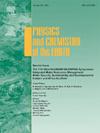Long-term assessment of groundwater contamination and associated health risks: A study of heavy metals in the Quaternary aquifer system in Great Hungarian Plain
IF 3
3区 地球科学
Q2 GEOSCIENCES, MULTIDISCIPLINARY
引用次数: 0
Abstract
This study investigates the spatiotemporal distribution and health risks of heavy metals in the Quaternary aquifer system Debrecen area, Hungary in the period between 2019 and 2024. A comprehensive methodology combining heavy metal pollution indices, multivariate statistics, uncertainty, and sensitivity analysis was employed. Heavy metal pollution (HPI) and ecological risk (ERI) indices were calculated based on arsenic (As), iron (Fe), and manganese (Mn). The results show an increase in both HPI and ERI values from 2019 to 2024, with higher pollution and ecological risk levels, driven by localized natural and anthropogenic activities. Building on these findings, the study evaluates the health risks associated with these heavy metals exposure through oral and dermal pathways for adults and children, using Hazard Quotients (HQ) and Hazard Indices (HI). Children demonstrated significantly higher non-carcinogenic risks compared to adults, with HI values exceeding the safety threshold (HI > 1) in 2024. Spatial analysis revealed expanding high-risk zones for both population groups, emphasizing an intensifying health threat over time. Monte Carlo simulation was employed to evaluate the HQ for individual metals and the cumulative HI. The results demonstrated consistently higher risk levels for children compared to adults across both periods. Arsenic emerged as the most significant concern, with HQ values for children frequently exceeding the safety threshold. Sobol sensitivity analysis revealed that exposure and physiological parameters are the dominant parameters influencing oral exposure risk, while dermal absorption parameters and skin area are critical for dermal exposure.
地下水污染及相关健康风险的长期评估:大匈牙利平原第四纪含水层系统中的重金属研究
本研究调查了 2019 年至 2024 年期间匈牙利德布勒森地区第四纪含水层系统中重金属的时空分布和健康风险。研究采用了重金属污染指数、多元统计、不确定性和敏感性分析相结合的综合方法。根据砷(As)、铁(Fe)和锰(Mn)计算了重金属污染(HPI)和生态风险(ERI)指数。结果表明,在局部自然和人为活动的推动下,2019 年至 2024 年的 HPI 和 ERI 值均有所上升,污染和生态风险水平更高。在这些研究结果的基础上,该研究利用危害商数(HQ)和危害指数(HI)评估了成人和儿童通过口腔和皮肤途径接触这些重金属所带来的健康风险。与成人相比,儿童的非致癌风险明显更高,2024 年的 HI 值超过了安全阈值(HI > 1)。空间分析表明,两个人群的高风险区都在扩大,强调了随着时间的推移,健康威胁在加剧。采用蒙特卡罗模拟来评估单个金属的 HQ 和累积 HI。结果表明,在这两个时期,儿童的风险水平始终高于成人。砷最受关注,儿童的 HQ 值经常超过安全阈值。Sobol 敏感性分析显示,暴露和生理参数是影响口腔暴露风险的主要参数,而皮肤吸收参数和皮肤面积对皮肤暴露至关重要。
本文章由计算机程序翻译,如有差异,请以英文原文为准。
求助全文
约1分钟内获得全文
求助全文
来源期刊

Physics and Chemistry of the Earth
地学-地球科学综合
CiteScore
5.40
自引率
2.70%
发文量
176
审稿时长
31.6 weeks
期刊介绍:
Physics and Chemistry of the Earth is an international interdisciplinary journal for the rapid publication of collections of refereed communications in separate thematic issues, either stemming from scientific meetings, or, especially compiled for the occasion. There is no restriction on the length of articles published in the journal. Physics and Chemistry of the Earth incorporates the separate Parts A, B and C which existed until the end of 2001.
Please note: the Editors are unable to consider submissions that are not invited or linked to a thematic issue. Please do not submit unsolicited papers.
The journal covers the following subject areas:
-Solid Earth and Geodesy:
(geology, geochemistry, tectonophysics, seismology, volcanology, palaeomagnetism and rock magnetism, electromagnetism and potential fields, marine and environmental geosciences as well as geodesy).
-Hydrology, Oceans and Atmosphere:
(hydrology and water resources research, engineering and management, oceanography and oceanic chemistry, shelf, sea, lake and river sciences, meteorology and atmospheric sciences incl. chemistry as well as climatology and glaciology).
-Solar-Terrestrial and Planetary Science:
(solar, heliospheric and solar-planetary sciences, geology, geophysics and atmospheric sciences of planets, satellites and small bodies as well as cosmochemistry and exobiology).
 求助内容:
求助内容: 应助结果提醒方式:
应助结果提醒方式:


